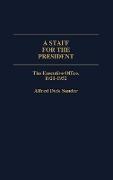- Start
- A Staff for the President
A Staff for the President
Angebote / Angebote:
Sander chronicles changes in the Executive Office of the President (EOP) paralleling change and expansion in the federal government, the executive branch, and the office of the president, from its inception to the end of the Truman administration...In his intriguing analysis of the historical dialectic surrounding theoretical questions about EOP Sander shines, showing the multi-colored underwear of a gray-flannel organization. The EOP becomes the playing field of a dynamic contest among differing constitutional and theoretical views. Sander has written a book about what could be a dull and lifeless topic, and made it enjoyable. Choice The creation of a staff to aid the chief executive in his immense management task was a crucial element in the development of the modern presidency. Focusing on the period that witnessed the most extensive changes in the executive branch, this book traces the evolution of the executive office of the President, and looks at the complex ways in which this organization has affected both the president's role and the operation of the federal government.
Sander explores the political and administrative issues raised by the creation of a separate corps of careerists serving the president and independent of the departments and concludes with an assessment of various proposals aimed at reorganizing and controlling the appointment and functions of the presidential staff. Following a historical overview of major shifts in the presidential role, the author discusses the gradual increase in presidential staff and institutional support that occurred in the 1920s. Sander next examines the evolution of Roosevelt's executive office and the important precedents that were set during his administration. The primary focus of the book is on the major expansion of the presidential staff that occurred during Truman's tenure. When Truman left office, the basic staff services that enable the president to carry out his duties were in place. These were the Bureau of the Budget, the Council of Economic Advisors, the National Security Resources Board, and the National Security Council.
Providing new insights on the forces and events that have shaped the institution of the presidency, this book will be of particular interest to those in the fields of political science, American political history, American public policy and public administration.
Folgt in ca. 15 Arbeitstagen

